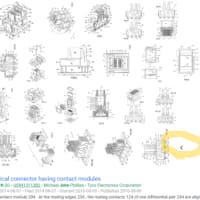US2018183047(JP)
"[0006] In lithium complex oxides such as lithium cobaltate (LiCoO2) or a ternary material (LiNi0.33Co0.33Mn0.33O2), lithium hydroxide remains as an unreacted synthetic substance, and this substance increases the pH level by coming into contact with water. A strong alkaline slurry with a pH level of higher than 11 corrodes an aluminum current collector at the time of coating and generates hydrogen gas in the interface between the active material layer and the aluminum current collector. Due to the hydrogen gas, the active material layer foams, and this leads to a decrease in electrode strength or the exfoliation or detachment of the active material layer. Furthermore, unfortunately, it is difficult to obtain a uniform electrode."
「[0005] しかしながら、コバルト酸リチウム(LiCoO2)や三元系材料(LiNi0.33Co0.33Mn0.33O2)などのリチウム複合酸化物は、合成未反応物質として水酸化リチウムが残存しており、水と接触してpH値を上昇させる。そして、pH値が11を超えるような強アルカリ性のスラリーでは、塗工時にアルミニウム集電体が腐食し、活物質層とアルミニウム集電体の界面で水素ガスを発生させる。この水素ガスにより、活物質層が発泡し、電極の強度低下や活物質層の剥離、脱落を引き起こし、また、均一な電極が得にくいという問題があった。 」
US2017352886(JP)
"[0098] Of the active materials described above, lithium salts of transition metal oxides are principally used as positive electrode active materials, and for example laminar rock salt-type and spinel-type lithium-containing metal oxides may be used. Specific compounds that are laminar rock salt-type positive electrode active materials include lithium cobaltate, lithium nickelate, and NCM {Li(Nix,Coy,Mnz), x+y+z=1} and NCA {Li(Ni1-a-bCoaAb)} and the like, which are referred to as ternary materials. Examples of spinel-type positive electrode active materials include lithium manganate and the like. Apart from oxides, phosphate salts, silicate salts and sulfur and the like may also be used. Examples of phosphate salts include olivine-type lithium iron phosphate and the like. One of these may be used alone as a positive electrode active material, or two or more may be combined and used as a mixture or composite."
「[0050] 上記活物質の内、正極活物質としては主に遷移金属酸化物のリチウム塩が用いられ、例えば、層状岩塩型及びスピネル型のリチウム含有金属酸化物を使用することができる。層状岩塩型の正極活物質の具体的な化合物としては、コバルト酸リチウム、ニッケル酸リチウム、並びに、三元系と呼ばれるNCM{Li(Ni x ,Co y ,Mn z )、x+y+z=1}及びNCA{Li(Ni 1-a-b Co a Al b )}等が挙げられる。また、スピネル型の正極活物質としてはマンガン酸リチウム等が挙げられる。酸化物以外にもリン酸塩、ケイ酸塩及び硫黄等が使用され、リン酸塩としては、オリビン型のリン酸鉄リチウム等が挙げられる。正極活物質としては、上記のうちの1種を単独で使用してもよく、2種以上を組み合わせて混合物又は複合物として使用してもよい。」
EP3285326(JP)
"[0081] In the third procedure, a wound body is prepared in a similar manner to that in the above-mentioned second procedure except for that a separator in which a polymer compound has been applied onto the both surfaces is used, and housed inside the sac-like exterior element. The polymer compound applied onto this separator is, for example, a polymer containing vinylidene fluoride as a component (a homopolymer, a copolymer or a multi-component copolymer) or the like. Specific examples are two-component copolymers containing polyvinylidene fluoride, vinylidene fluoride and hexafluoropropylene as components, three-component copolymers containing vinylidene fluoride, hexafluoropropylene and chlorotrifluoroethylene as components, and the like. In addition, other one kind or two or more kinds of polymer compound (s) may also be used together with the polymer containing vinylidene fluoride as a component. Subsequently, an electrolyte is prepared and injected inside the exterior element, and the opening of the exterior element is tightly sealed by using a heat melt process or the like. Subsequently, the exterior element is heated while applying a weight to attain tight-adhesion of the separator to the positive electrode and the negative electrode via the polymer compound. Since the polymer compound is impregnated with the electrolyte by this way, the polymer compound is gelled and thus an electrolyte layer is formed."
「[0077] 第3手順では、高分子化合物が両面に塗布されたセパレータを用いることを除き、上記した第2手順と同様に、巻回体を作製して袋状の外装部材の内部に収納する。このセパレータに塗布する高分子化合物は、例えば、フッ化ビニリデンを成分とする重合体(単独重合体、共重合体または多元共重合体)などである。具体的には、ポリフッ化ビニリデンや、フッ化ビニリデンおよびヘキサフルオロプロピレンを成分とする二元系共重合体や、フッ化ビニリデン、ヘキサフルオロプロピレンおよびクロロトリフルオロエチレンを成分とする三元系共重合体などである。なお、フッ化ビニリデンを成分とする重合体と一緒に、他の1種類または2種類以上の高分子化合物を用いてもよい。続いて、電解液を調製して外装部材の内部に注入したのち、熱融着法などを用いて外装部材の開口部を密封する。続いて、外装部材に加重をかけながら加熱して、高分子化合物を介してセパレータを正極および負極に密着させる。これにより、電解液が高分子化合物に含浸するため、その高分子化合物がゲル化して電解質層が形成される。 」
US9647261(JP)
"(2) The layered lithium transition metal composite oxide includes a compound represented by a general formula LiMO2. Herein, M comprises at least one species of transition metal such as Ni, Co, Mn, etc., and may further comprise other metal(s) or non-metal(s). Examples of the composite oxide include a so-called single-transition-metal-type lithium transition metal composite oxide comprising a single species among the transition metals, a so-called two-transition-metal-type lithium transition metal composite oxide comprising two species among the transition metals, and a three-transition-metal-type lithium transition metal composite oxide comprising Ni, Co and Mn as transition metals. In particular, a three-transition-metal-type lithium transition metal composite oxide is preferable. An example of the three-transition-metal-type lithium transition metal composite oxide can be represented by a general formula Li(LiaMnxCoyNiz)O2 (in the formula, a, x, y and z are real numbers that satisfy a+x+y+z=1)."
「[0044] (2)層状構造のリチウム遷移金属複合酸化物としては、一般式:LiMO 2 ;で表される化合物が挙げられる。ここで、Mは、Ni,Co,Mn等の遷移金属元素の少なくとも1種を含み、他の金属元素または非金属元素をさらに含み得る。上記複合酸化物としては、例えば、上記遷移金属元素を1種含むいわゆる一元系リチウム遷移金属複合酸化物、上記遷移金属元素を2種含むいわゆる二元系リチウム遷移金属複合酸化物、遷移金属元素としてNi、CoおよびMnを構成元素として含む三元系リチウム遷移金属複合酸化物が挙げられる。なかでも、三元系リチウム遷移金属複合酸化物が好ましい。上記三元系リチウム遷移金属複合酸化物としては、例えば一般式:Li(Li a Mn x Co y Ni z )O 2 (前式中のa、x、y、zはa+x+y+z=1を満足する実数);で表される三元系リチウム遷移金属複合酸化物が挙げられる。 」
US2017352882(JP)
"[0068] As it is apparent from Chemical Formula (1) above, the silicon-containing alloy according to a preferred embodiment of the present invention (having a composition of SixSnyMzAa) is a binary system (in the case of y=0) of Si and M (transition metal) or a ternary system (in the case of y>0) of Si, Sn, and M (transition metal). Between them, the silicon-containing alloy is more preferably a ternary system of Si, Sn and M (transition metal) from the viewpoint of cycle durability. In addition, in the present specification, the term “an unavoidable impurity” means a component that is present in the raw material or has been unavoidably mixed into the Si-containing alloy during the production process. The unavoidable impurity is not originally required, but it is in a trace amount and does not affect the characteristics of the Si alloy, and it is thus allowable impurity. "
「[0056] 上記化学式(1)から明らかなように、本発明の好ましい実施形態に係るケイ素含有合金(Si x Sn y M z A a の組成を有するもの)は、SiおよびM(遷移金属)の二元系であるか(y=0の場合)、Si、SnおよびM(遷移金属)の三元系である(y>0の場合)。なかでも、Si、SnおよびM(遷移金属)の三元系であることが、サイクル耐久性の観点からはより好ましい。また、本明細書において「不可避不純物」とは、Si含有合金において、原料中に存在したり、製造工程において不可避的に混入したりするものを意味する。当該不可避不純物は、本来は不要なものであるが、微量であり、Si合金の特性に影響を及ぼさないため、許容されている不純物である。 」
最新の画像[もっと見る]
-
 DAZN(ダゾーン):メール配信停止ボタンくらい付けとけ
5日前
DAZN(ダゾーン):メール配信停止ボタンくらい付けとけ
5日前
-
 DAZN(ダゾーン):メール配信停止ボタンくらい付けとけ
5日前
DAZN(ダゾーン):メール配信停止ボタンくらい付けとけ
5日前
-
 バズリクソンズA2:第15週
1週間前
バズリクソンズA2:第15週
1週間前
-
 バズリクソンズA2:第14週
2週間前
バズリクソンズA2:第14週
2週間前
-
 Google Patents Advanced Searchで全部表示される図面の表示を隠す
2週間前
Google Patents Advanced Searchで全部表示される図面の表示を隠す
2週間前
-
 召合せ框(めしあわせかまち)
3週間前
召合せ框(めしあわせかまち)
3週間前
-
 バズリクソンズA2:第13週
3週間前
バズリクソンズA2:第13週
3週間前
-
 バズリクソンズA2:第13週
3週間前
バズリクソンズA2:第13週
3週間前
-
 バズリクソンズA2:第13週
3週間前
バズリクソンズA2:第13週
3週間前
-
 バズリクソンズA2:第12週
4週間前
バズリクソンズA2:第12週
4週間前
















※コメント投稿者のブログIDはブログ作成者のみに通知されます